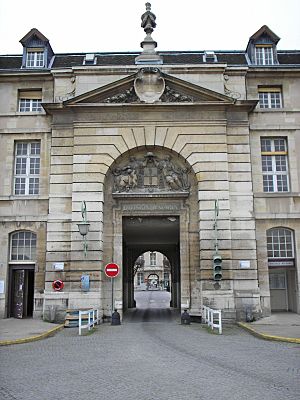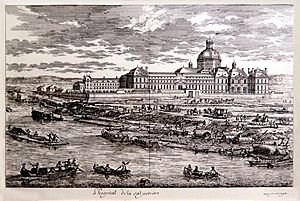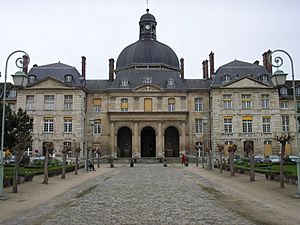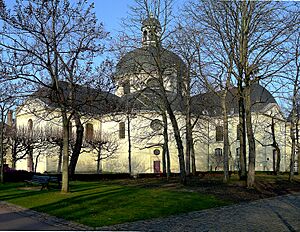Pitié-Salpêtrière Hospital facts for kids
Quick facts for kids Pitié-Salpêtrière Hospital |
|
|---|---|
| AP-HP Sorbonne University Hospital Group | |

The Mazarin entrance to the Pitié-Salpêtrière Hospital
|
|
| Geography | |
| Location | 47–83 Boulevard de l'Hôpital, 75013 Paris, France |
| Organisation | |
| Care system | Public, Charitable |
| Hospital type | Teaching |
| Services | |
| Emergency department | Yes |
The Pitié-Salpêtrière University Hospital is a very large hospital in Paris, France. It's known as a "charitable hospital" because it helps people in need. It's also a "teaching hospital," which means it's connected to Sorbonne University and helps train new doctors and medical staff.
Contents
A Look at the Hospital's History
The Salpêtrière wasn't always a hospital. It started as a factory that made gunpowder. But in 1656, King Louis XIV decided to turn it into a place for poor women in Paris. It was part of a bigger project called the General Hospital of Paris. This main building helped women who had learning difficulties, mental health challenges, or epilepsy, as well as those who were simply poor.
In 1657, it joined with another place called the Pitié, which was for children who were beggars or orphans. The children there helped make sheets and clothes for the hospital and the army. Between 1663 and 1673, some women from the Pitié-Salpêtrière were sent to help build new communities in the Americas. They were part of a group known as the "King's Daughters."
The hospital's design was much admired, thanks to architects like Libéral Bruant. By 1669, its transformation was complete. Later, a special area was added for women who had committed minor offenses.
Changes Over Time
Before the French Revolution, the Salpêtrière didn't treat sick people. Those who were ill went to another hospital called the Hôtel-Dieu. The Salpêtrière was more like a huge shelter, caring for about 10,000 people.
During a difficult time in 1792, a crowd entered the Salpêtrière. Some people who were held there were released. Sadly, some others, including those with mental health conditions, were harmed.
Towards the end of the 1700s, a doctor named Philippe Pinel started new, kinder ways of treating people with mental health issues. He became the chief doctor at the Salpêtrière in 1794. A statue of him stands outside the hospital today.
After Pinel, other important doctors like Jean-Étienne Dominique Esquirol and Jean-Pierre Falret continued to study and understand mental health conditions. Falret, for example, helped us learn more about bipolar disorder.
Pioneering Medical Discoveries
A remarkable scientist named Guillaume-Benjamin Duchenne de Boulogne visited the Salpêtrière for over 30 years. He was a brilliant medical researcher who used new tools like electricity and photography to study patients with nerve problems. He described many muscle diseases, including Duchenne muscular dystrophy, which is named after him. His work even helped Charles Darwin write his famous book, Expression of the Emotions in Man and Animals.
Later, Jean-Martin Charcot became a very famous doctor at the Salpêtrière. He made the hospital a leading place for studying the brain and nerves. He taught many students from all over the world. Charcot helped doctors understand many diseases, including epilepsy and stroke. He also suggested that Parkinson's disease be named after James Parkinson, who first described it.
One of Charcot's most famous students was Sigmund Freud, who later became known as the "father of psychoanalysis." Many other important doctors and scientists also studied or worked at the Salpêtrière, learning from its experts.
Joining Forces
The Hôpital de la Pitié, which started around 1612, moved next to the Salpêtrière in 1911. In 1964, they officially joined together to become the Groupe Hospitalier Pitié-Salpêtrière. Today, it's a general teaching hospital with many different medical departments.
The Paris Brain Institute, a major research center for the brain and spine, has been located at the hospital since 2010.
Famous Patients and People
Many well-known people have been treated at the Salpêtrière Hospital. These include famous athletes like Michael Schumacher and Ronaldo, and important figures like Prince Rainier of Monaco and former French president Jacques Chirac.
Sadly, some famous people have also passed away at the Pitié-Salpêtrière. These include singer Josephine Baker in 1975, philosopher Michel Foucault in 1984, and Diana, Princess of Wales in 1997 after a car accident. Bicycle racer Laurent Fignon passed away in 2010, and rapper Werenoi in 2025.
Hospital Buildings
The Hospital Chapel
The Chapelle de la Salpêtrière (Hospital Chapel) is a masterpiece designed by Libéral Bruant, the same architect who designed Les Invalides. It was built around 1675. The chapel has a unique shape, like a Greek cross, with four main sections. Each section could hold about 1,000 people. The central dome has circular windows that let in lots of light.
Philippe Pinel Monument
In front of the hospital's main entrance, there is a large bronze statue of Philippe Pinel. He was the chief doctor of the hospital from 1795 until his death in 1826. Pinel was a pioneer in vaccination. He started a clinic for inoculations in 1799, and the first vaccination in Paris was given at the Salpêtrière in April 1800.
Notable Doctors Who Worked Here
Many important doctors and scientists have worked at the Pitié-Salpêtrière throughout its history. Here are some of them:
- Philippe Pinel (1745–1826)
- Jean-Étienne Esquirol (1772–1840)
- Duchenne de Boulogne (1806–1875)
- Jean-Martin Charcot (1825–1893), known as the founder of modern neurology
- Sigmund Freud (1856–1939), a student of Charcot and the "father of psychoanalysis"
- Joseph Babinski (1857–1932), another student of Charcot
- Georges Gilles de la Tourette (1857–1904), a neurologist
- Maria Montessori (1870–1952), famous for her work in education
- Christian Cabrol (1925–2017), a heart surgeon who performed Europe's first heart transplantation in 1968.
- Iradj Gandjbakhch (born 1941), also a heart surgeon who performed the first heart transplant with Dr. Cabrol.
See also
 In Spanish: Hospital de la Pitié-Salpêtrière para niños
In Spanish: Hospital de la Pitié-Salpêtrière para niños
- AP-HP Sorbonne University Hospital Group
- Bicêtre Hospital
- A Clinical Lesson at the Salpêtrière
- General Hospital of Paris
- Jacques-René Tenon
External links
- Pitié-Salpêtrière Hospital
- History of La Salpêtrière
- Salpêtrière Hospital records, 1859–1942, Harvard Medical Library






